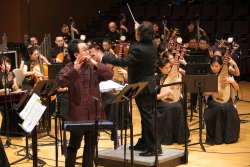 |
Ricky Yeung Wai-kit’s dizi, or Chinese bamboo flute, recital was not your typical graduate recital done on a shoestring with a few friends. As well as being the first dizi performance doctoral student in China (at China Conservatory in Beijing), Yeung is a sought-after performer in Hong Kong and Asia, and for this concerto recital he had the Guangdong Chinese Orchestra and a number of distinguished soloists supporting him. The programme was an appealing tour of Guangdong traditional music which deserves to be more widely known for its poetic melodies and bright festive sounds.
It kicked off in fine style with a piece called Chaoyang Dizi Suite: Gongs and Drums Music, Happily Going Up the Mansion. Chen Zuohui, principal percussionist of the Guangdong Chinese Orchestra, acted as conductor, leading from the front while playing his crimson Chinese drum with bold arm gestures and playful shakes of the drumsticks. This lively piece showed off the group’s mix of plucked strings, woodwinds and percussion, as if the drum’s painted dragon had come alive in sound.
Yeung used at least six flutes in the concert, including three in one piece alone. He commanded surprising power and resonance for just a bit of bamboo. The tone was clear and liquid even while using the special membrane, fitted over a hole, that gave a characteristic buzz to the dizi tone. Chinese music is richly ornamented with trills and grace notes and Yeung integrated them skilfully into the music so they sounded spontaneous and natural. Bending and sliding the pitches is another part of the style that imitates the Chinese language so expressively. Yeung is an accomplished virtuoso but this concert did not push him to the limit in notes per second - it was not so much about fireworks and virtuosity as about exploring lesser-known repertoire, including several Hong Kong premieres.
A high point of the programme was a duet with the celebrated player Yu Qiwei on the yehu, a type of huqin, or Chinese violin, with a coconut shell body. The tuning was not standard Western tuning and especially the 4th and 7th steps of the scale were pleasingly altered, giving a distinct sense of locality. The sound of the yehu is mellow and gentle and Yu danced on the strings with effortless mastery. The flute Yeung used in this piece was the xiao dizi, smaller, higher pitched and without a membrane, and the nimble interplay between the two was a delight.
The United We Go Concerto by Wang Danhong, based on traditional Guangdong music, was a concerto for five soloists and orchestra. This and the other orchestral pieces except the first were conducted by Zhang Lei. The solo instruments were the bowed strings gaohu and yehu, the hammered string yangqin, and the plucked string qinqin, along with the dizi. This fascinating combination of bowing, hammering, plucking, tremolo-ing and blowing gave each instrument its own distinct personality but the excellent performers wove the intricate lines beautifully together. Pan Weiwen especially played with zest on the yangqin, the ancestor of the piano.
Dizi player Chen Yunyin joined Yeung for the double dizi concerto, Winter Sunshine by Zhang Weilang. This duet was a joyful conversation between the two flutes, with Chen’s strong, glowing sound a good match for Yeung. However, at a few points the orchestra covered up the sound of the flutes, especially Chen. In other pieces on the programme as well the balance was not perfect and the inner lines and background parts were too prominent. Some attacks were not quite together and the group tended to stay at a medium-loud dynamic rather than exploiting the full range of contrast. On the other hand, the individual players were excellent, so the few limitations did not take away from the enjoyment of the music. The erhu section, corresponding to the first violins in a Western orchestra, were beautifully united in phrasing and tone.
The last two pieces, Spring Happiness by Cui Quan and Zhang Weiliang and Sea of South China, also by Weiliang, used the orchestra’s resources to the fullest and the group sounded well-balanced and cohesive at that point. This was the Hong Kong premiere of both works, and they were brilliant in orchestration and dramatic in expression. Here the combination of flowing, lyrical melodies scored for orchestra tutti and fast-moving, dance-like passages made for highly satisfying music that showed off the best of the Chinese instruments.
The Chinese orchestra in this format is a modem invention, modelled in part on the Western orchestra, and is still in development. Concerts like this one help its evolution. Composers like Weiliang and Cui bring out the best of its advantages, namely the rich variety of sounds and colours, especially strings and percussion. It has some disadvantage in less resonant low strings and brass, and these issues are worked out differently in each piece. It remains to be seen what the “classic” form of the ensemble may turn out to be. But a successful concert such as this with new pieces for the repertoire certainly shows some inviting possibilities.
本網站內一切內容之版權均屬國際演藝評論家協會(香港分會)及原作者所有,未經本會及/或原作者書面同意,不得轉載。








